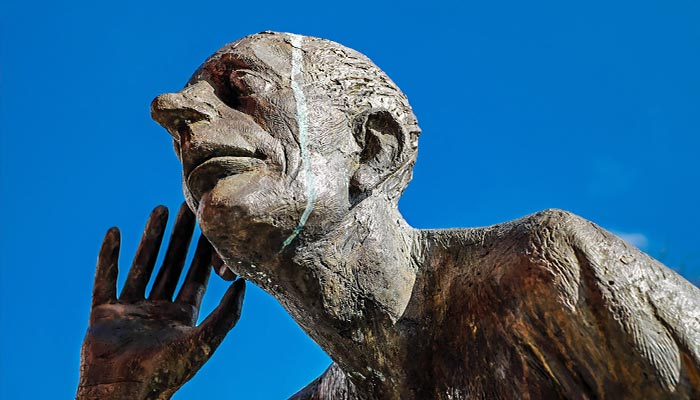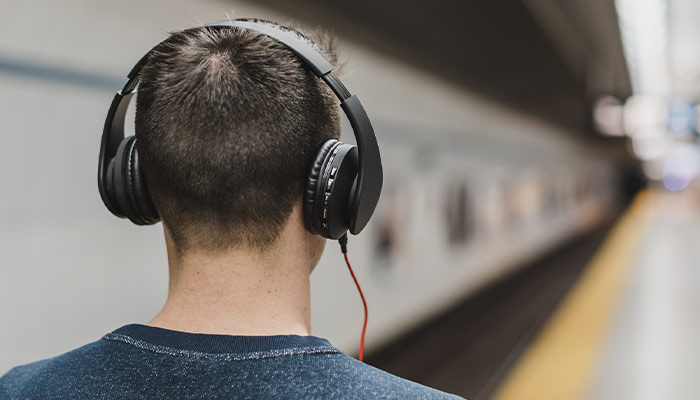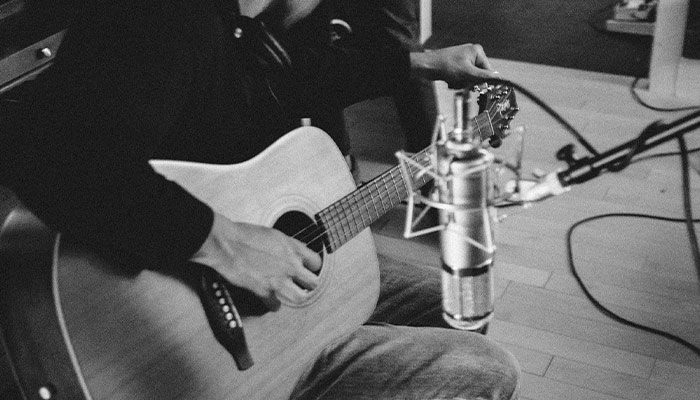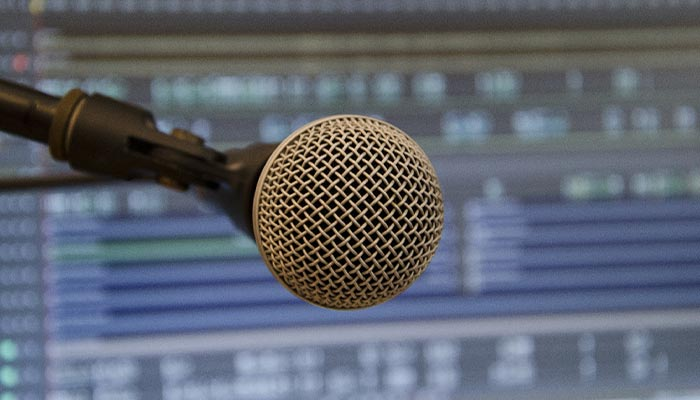Entering the world of professional audio and music production is relatively easy these days. All you need to do is download a digital audio workstation (DAW) and start working on your new project. Often, these DAWs do most of the job themselves, creating the perfect creative environment for your audio project.
However, as you start digging deeper into the potential of your software, you’ll realize there are audio settings you can adjust to improve the quality of your content. One of those settings is undoubtedly the sample rate.
Knowing what sample rates are and which rate is the best for your project is a fundamental aspect of audio production. One that can change the quality of your creations dramatically. There’s no one-size-fits-all answer when it comes to sample rate. Depending on the content you’re bringing to life, you’ll have to choose the suitable settings to guarantee optimal results.
In this article, I’ll explain what sample rate is why it’s essential. I’ll also go over which sample rate you should use based on whether you’re a music producer, an audio engineer working in video, or a voice-over actor.
It would be impossible to explain the importance of sample rate without giving an overview of human hearing and how audio gets converted from analog to digital. So I’ll start the article with a brief introduction to those topics.
This is a complex topic and quite tech-heavy. I’ll try to keep it as straightforward as possible. However, a basic understanding of audio frequencies and how sound travels through space would help. This article can also help a novice choose the optimal setup for their recording sessions.
Let’s dive in!

Before we delve into the intricacies of sample rates, I want to clarify a few things about how we hear and interpret sounds. This helps us understand how sounds are recorded and reproduced. This gives you the information you need to highlight the importance of the sample rate.
Sound travels through the air in waves. When a sound wave enters the ear canal and gets to the eardrum, the latter vibrates and sends these vibrations to three tiny bones called the malleus, incus, and stapes.
The inner ear transforms vibrations into electrical energy. The brain then interprets the signal. Each sound vibrates at a specific sine wave frequency, making it unique as if it was a sonic fingerprint. The frequency of a sound wave determines its pitch.
Humans perceive the frequency of sound waves as pitch. We can hear sounds between 20 and 20,000 Hz and are most sensitive to frequencies between 2,000 and 5,000 Hz. As we get older, we lose the ability to listen to higher frequencies. Some animals, like dolphins, can hear frequencies up to 100,000 Hz; others, like whales, can hear infrasonic sounds down to 7 Hz.
The longer the wavelength of audible sound, the lower the frequency. For instance, a low-frequency wave with a wavelength of up to 17 meters can correspond to 20 Hz. Conversely, the highest frequency waves, up to 20,000 Hz, can be as small as 1.7 centimeters.
The frequency range audible by Humans is limited and clearly defined. Therefore, audio recording and playback devices focus on capturing sounds human ears can hear. All the recorded sounds you hear, from your favorite CDs to field recordings in documentaries, are made using devices that precisely capture and reproduce sounds that humans can hear.
Technology has evolved based on our auditory capabilities and needs. There is a wide range of frequencies that our ears and brains won’t register, as evolution decreed they weren’t necessary for our survival. Nevertheless, today we have audio recording tools at our disposal that allow capturing sounds that even the most trained human ear wouldn’t be able to recognize.
As we’ll see below, it turns out frequencies we can’t hear can still affect the ones within our audible range. So in a way, it’s essential to take them into account when you’re recording audio. On the other hand, whether recording frequencies outside our audible spectrum has an impact on the audio quality is still a matter of debate.
The sample rate comes into play when we convert an analog signal (natural) audio to digital data so that our electronic devices can process it and reproduce it.
Converting a sound wave from analog to digital requires a recorder that can translate natural sounds into data. Therefore, the transition between analog waveforms to digital information is a necessary step when you record audio on your PC through a digital audio workstation.
When recording, specific traits of a sound wave, like its dynamic range and frequency, are translated into digital pieces of information: something our computer can understand and interpret. To transform an original waveform into a digital signal, we need to describe the waveform mathematically by capturing a large quantity of “snapshots” of this waveform until we can fully describe its amplitude.
These snapshots are called sample rates. They help us identify the features that define the waveform so that the computer can recreate a digital version of the sound wave that sounds precisely (or almost) like the original.
This process of converting the audio signal from analog to digital can be done by an audio interface. They connect musical instruments to your PC and DAW, recreating the analog audio as a digital waveform.
Just like the frame rate for videos, the more information you have, the better. In this case, the higher the sample rate, the more information we have about a specific frequency content, which can then be converted perfectly into bits of information.
Now that we know how to use our digital audio workstations to record and edit sounds, it’s time to look into the importance of sample rate and see how it affects audio quality.

Simply put, the sample rate is the number of times per second audio is sampled. For instance, at a sample rate of 44.1 kHz, the waveform is captured 44100 times per second.
According to the Nyquist-Shannon theorem, the sample rate should be at least two times the highest frequency you intend to capture to represent an audio signal accurately. Wait, what?
In a nutshell, if you want to measure the frequency of a sound wave, you must first identify its complete cycle. This comprises a positive and negative stage. Both stages need to be detected and sampled if you want to precisely capture and recreate the frequency.
By using the standard sample rate of 44.1 kHz, you’ll perfectly record frequencies slightly higher than 20,000 Hz, which is the highest frequency level humans can hear. This is also why 44.1 kHz is still considered the standard quality for CDs. All the music you listen to on CD has this standard sample rate.
Why 44.1 kHz and not 40 kHz, then? Because, when the signal is converted to digital, frequencies above the ones audible by humans filter out through a low pass filter. The additional 4.1kHz gives the low pass filter enough room, so it won’t affect the high-frequency content.
Using a higher sample rate of 96,000 Hz will provide you with a range of frequencies up to 48,000 Hz, way above the human hearing spectrum. Nowadays, good quality music recording equipment allows recording at an even higher sample rate of 192,000 Hz, therefore capturing audio frequencies up to 96,000 Hz.
Why do we have the possibility to record such high frequencies if we can’t hear them in the first place? Many audio professionals and engineers agree that frequencies above the audible spectrum can still have an impact on the overall sound quality of a recording. The subtle interference of these ultrasonic sounds, if not captured correctly, can create a distortion that interferes with frequencies within the 20 Hz – 20,000 Hz spectrum.
In my opinion, the negative impact of these ultrasonic frequencies on the overall sound quality is negligible. Nevertheless, it’s worth analyzing the most common issue you may come across when recording sounds. It’ll help you decide whether increasing your sample rate would improve the quality of your recordings.
Aliasing is a phenomenon that occurs whenever the audio is not reinterpreted correctly by the sample rate you’re using. It’s a significant concern for sound designers and audio engineers. It’s the reason why many of them opt for a higher sample rate to avoid the issue.
When higher frequencies are too high to be captured by the sample rate, they might be reproduced as lower frequencies. This is because every frequency over the Nyquist frequency limit (which, if you’re recording at 44.1 kHz, would be 2,050 Hz), the audio will reflect backward, becoming an “alias” of lower frequencies.
An example should help clarify this phenomenon. If you record audio using a sample rate of 44,100 Hz and during the mixing phase, you add some effects that push the higher frequencies up to 26,000 Hz. Because of this, the additional 3,950 Hz would bounce back and create an audio signal of 18,100 Hz that would interfere with the natural frequencies.
The best way to avoid this problem is to use higher sampling rates on your digital audio workstation. In this way, you’ll make certain frequencies above 20,000 Hz are captured correctly. Then, you’ll be able to use them should that be necessary.
There are also low-pass filters that discard frequencies above the Nyquist frequency limit and thus prevent aliasing from occurring. Finally, upsampling through dedicated plug-ins is also a valid option. CPU usage will be way higher than before, but aliasing will be less likely to occur.
The higher the sampling rate, the more accurate the sound wave representation will be. Lower sampling rates mean fewer samples per second. With less audio data, the audio representation will be approximate, to some extent.
The most common sampling rate values are 44.1 kHz and 48 kHz. 44.1 kHz is the standard rate for audio CDs. Generally, movies use 48 kHz audio. Even though both sample rates can accurately capture the entire frequency spectrum of human hearing, music producers and engineers often choose to use higher sample rates to create hi-res recordings.
Learn more about the main differences between 44.1kHz vs 48kHz audio sampling rates before choosing one!
When it comes to mixing and mastering music, for instance, it’s essential to have as much data as possible and capture every frequency, which engineers can use to deliver the perfect sound. Even though these ultrasonic frequencies can’t be heard, they still interact and create intermodulation distortion that’s clearly audible.
Here are the options if you want to explore high sampling rates:
As I mentioned earlier, frequencies humans can’t hear still manipulate and affect the audible ones. This sample rate is an excellent option for mixing and mastering music. It produces less aliasing (sounds that can’t be represented correctly within the sample rate used) when converting from digital to analog.
Similar to 88.2 kHz, recording music at 96 kHz is ideal for mixing and mastering. However, make sure your computer can handle this, as each recording will require more processing power and storage space.
Modern studio-quality audio interfaces support up to 192KHz sampling rates. This is four times the standard CD quality, which may seem a bit of an exaggeration. However, using this sample rate can be helpful if you’re planning to slow down your recordings significantly, as they will maintain a hi-res audio quality even at half speed.
Once again, the difference between these sample rates can be very subtle. Although, many audio engineers believe it’s fundamental to obtain as much information as possible from the original recording in order to recreate audio that’s truly authentic.
This approach is also possible thanks to the vast improvement in technology we’ve experienced over the last decade. Home computers’ storage space and processing capabilities have dramatically increased the potential of what we can do with them. So why not make the most of what we have at our disposal?
Here’s the catch, there’s a risk of overloading your PC and adding unnecessary stress to your CPU usage. Therefore, unless you clearly hear a difference in the quality of your recordings, I’d recommend opting for the standard sample rates that have been used for years and provide pristine results.

There are two answers to this question, a simple and a more complicated one. Let’s start with the former.
Overall, recording at 44.1kHz is a safe option that will provide you with high-quality recordings, regardless of the type of audio project you’re working on. 44.1kHz is the most common sample rate for music CDs. It captures the entire audible frequency spectrum accurately.
This sample rate is ideal because it won’t use much disk space or more CPU power. Yet it will still deliver the authentic sound you need for your professional recordings.
If you’re working in the movie industry, then the best sample rate is 48 kHz, as it’s the industry standard. In terms of audio quality, there’s no difference between these two sample rates.
Now comes the more complicated answer. By capturing every detail of a recording, you will ensure that the audio is identical to the original sound. If you’re recording an album, audio frequencies can be modulated and adjusted to the point when ultrasonic frequencies may subtly affect the audible ones.
If you have enough experience and your equipment allows you to record at a high sample rate without issues, you should give it a go. The question of whether the audio quality improves with higher sample rates is still debatable. You may not hear any difference, or you may realize your music is now deeper and richer. I suggest you try all sample rates and hear for yourself if anything changes.
If you’re planning to slow down your recordings significantly, you should definitely try higher sampling rates. Some engineers claim to hear the difference between standard and higher sample rates. Yet even if they did, the difference in quality is so negligible that 99.9% of listeners won’t notice it.
Each DAW is different, but the ones that offer the possibility to change the sample rate do so in somewhat similar ways. As far as I know, you can change the sample rate on all the most popular digital audio workstations, such as Ableton, FL Studio, Studio One, Cubase, Pro Tools, and Reaper. Even the free software Audacity allows changing the sample rate.
In most cases, you’ll be able to adjust the sample rate of your DAW in the audio preferences. From there, you can manually change the sample rate and save the updated settings. Some DAWs automatically detect the optimal sample rate, usually 44.1kHz or 96 kHz.
I recommend you do a few tests before you start recording. Increasing the sample rate will undoubtedly reduce latency and the chances of aliasing. Yet it’ll also put additional stress on your CPU. You’ll also end up with much larger file sizes. In the long run, this may affect your computer’s performance by reducing disk space.
If you want to lower the sample rate, make sure you don’t go anywhere below 44.1kHz as per the Nyquist frequency theorem discussed above.
Whatever you do, you need to ensure all audible frequencies are captured accurately. Everything else has a minimal impact on your audio or can be fixed during post-production.

If you have a home recording studio, choosing the sample rate is one of the first decisions you’ll have to make before recording sounds.
As a musician myself, I suggest starting with the easiest, most common rate: 44.1kHz. This sampling rate captures the entirety of the human hearing spectrum, doesn’t occupy a lot of disk space, and won’t overload your CPU power. But, on the other hand, recording at 192KHz and having your laptop freezing every two minutes makes no sense, doesn’t it?
Professional recording studios can record at 96kHz or even 192kHz. Then resample to 44.1kHz later to comply with the industry standards. Even audio interfaces used for home recording allow sample rates up to 192kHz. In addition, most DAWs offer the possibility to adjust the sample rate accordingly before you start recording.
As technology moves forward, higher resolution sampling rates might become more popular. However, the overall improvement in terms of audio quality remains debatable. Basically, as long as you don’t go anywhere lower than 44.1kHz, you’ll be absolutely fine.
If you just started working with audio, I’d recommend sticking with the most common sample rates. Then, as you progress and become more confident with your equipment, try higher sample rates. See if using them has an actual, quantifiable impact on audio quality.
If not, save yourself the trouble and go for 44.1kHz. If audio quality standards change, you can always upsample your audio material in the future. Upsampling is a mostly automated process that doesn’t have a negative impact on the overall quality of your sound.
Good luck!